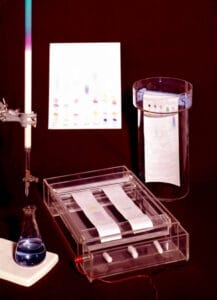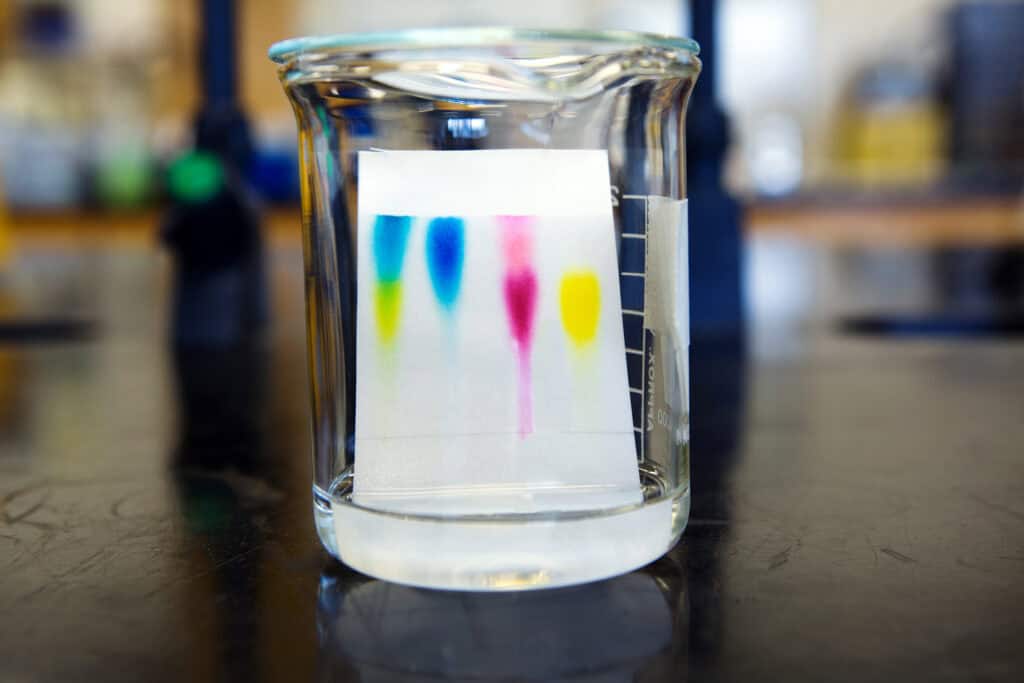There are several types of chromatography, and the history is rich with exploration. This is the beginning of a blog series that dives deeper into the lab technique, starting with Mikhail Tsvet, who first started to explore the colourful world around us.
History of Chromatography
The first chromatography column was invented in 1901 by Russian botanist Mikhail Tsvet, who was studying plant pigments with the goal of separating them for detailed analysis. He developed a method called liquid-adsorption chromatography, which involved passing an organic solution of plant pigments—such as chlorophylls and carotenoids—through a vertical glass column packed with calcium carbonate as the adsorbent. As the solution moved through the column, the pigments separated into distinct, colorful bands, revealing that the green, yellow, and orange pigments could be individually isolated. This pioneering work, first described in presentations by Tsvet in 1901 and later published in German botanical journals in 1906, introduced the term “chromatography,” meaning “color writing,” because the color bands visually represented the separation process .
Although highly effective, Tsvet’s discovery initially received little attention outside Russia due to his publications being mostly in Russian and the political upheaval at the time. Additionally, attempts by other scientists to replicate his work failed because they used overly aggressive adsorbents that destroyed the pigments. The method fell into obscurity until roughly a decade after Tsvet’s death, when researchers like Richard Kuhn, Edgar Lederer, and later A.J.P. Martin and R.L. Synge revived and expanded upon his ideas. With this, the history of chromatography became more than a footnote, it became a cornerstone of analytical methods. These scientists developed new forms of chromatography, such as partition chromatography and gas chromatography, which built on Tsvet’s foundation and transformed chromatography into a fundamental analytical tool across chemistry, biology, and medicine .
 Chromatography started to become widely used as an analytical method primarily in the 1930s and 1940s. Early chromatography work by Russian botanist Mikhail Tsvet in the early 1900s laid the foundation, but the technique gained broad scientific utility later, especially with innovations like paper chromatography in the 1940s by Archer Martin and Richard Synge, and the development of gas chromatography in the late 1940s and early 1950s. By the 1940s, chromatography was becoming widely applicable for chemical separation and analysis tasks, especially in biochemistry and petroleum chemistry. The development of new forms, including paper chromatography, gas chromatography, and later liquid chromatography, expanded its use significantly across scientific fields .
Chromatography started to become widely used as an analytical method primarily in the 1930s and 1940s. Early chromatography work by Russian botanist Mikhail Tsvet in the early 1900s laid the foundation, but the technique gained broad scientific utility later, especially with innovations like paper chromatography in the 1940s by Archer Martin and Richard Synge, and the development of gas chromatography in the late 1940s and early 1950s. By the 1940s, chromatography was becoming widely applicable for chemical separation and analysis tasks, especially in biochemistry and petroleum chemistry. The development of new forms, including paper chromatography, gas chromatography, and later liquid chromatography, expanded its use significantly across scientific fields .
Today, chromatography’s origins are celebrated as a crucial milestone that opened pathways for detailed chemical analysis by separating complex mixtures into their components visually and quantitatively.
The Major Types of Chromatography
Chromatography now encompasses a range of techniques, each suited to different sample types and scientific questions:
-
Paper Chromatography: One of the earliest types, this uses filter paper to separate coloured compounds, such as plant pigments or food dyes. It’s a favourite in classrooms for its simplicity and visual results. In fact, we have a hands on science experiment that is family friendly we do at Insanitek regularly to show what colours are in markers.
-
Thin Layer Chromatography (TLC): Similar to paper chromatography, but employs a thin layer of silica or alumina on a glass or plastic plate as the stationary phase. TLC delivers quick, clear separations and is widely used for analysing organic compounds.
-
Column Chromatography: Here, the stationary phase is packed into a vertical column. This versatile format includes advanced types like gas chromatography (GC) and liquid chromatography (LC).
-
Gas Chromatography (GC): Uses an inert gas to carry vaporised samples through columns, separating volatile substances—ideal for environmental testing or flavor analysis.
-
High-Performance Liquid Chromatography (HPLC): A high-tech evolution, HPLC pushes liquid samples through columns under pressure for fast, highly resolved separations—essential in pharmaceuticals and biotech.
-
-
Ion Exchange Chromatography: Separates molecules based on charge using resin beads and is especially crucial for purifying proteins and water treatment.
-
Size Exclusion (Gel Filtration) Chromatography: Sorts molecules by size, useful for analysing large biomolecules or polymers.
-
Affinity Chromatography: Employs highly specific biological interactions (like enzyme and substrate or antibody and antigen) to separate target analytes.
These are just a sampling of the primary methods; chromatography also includes hydrophobic interaction, pseudoaffinity, chiral, and two-dimensional techniques—each with a unique purpose and set of tools. It’s truly a remarkable method to specialise in, and one that you can spend decades mastering and never truly get them all.
Series Preview: Tools and Techniques Explored
Over the coming weeks, this blog series will:
-
Dive deep into each major type of chromatography
-
Explain when and why each method is used
-
Break down the key tools and equipment, from columns and plates to detectors and autosamplers
- Give an lesson that you can do with your classes.
Whether preparing for the first days in the lab or simply curious about how scientists “see the invisible,” please enjoy how these approachable guides that demystify the science and show how each tool shapes discovery.
Stay tuned as the journey into the colourful, precise world of chromatography—and the essential lab tools behind it—continues!
